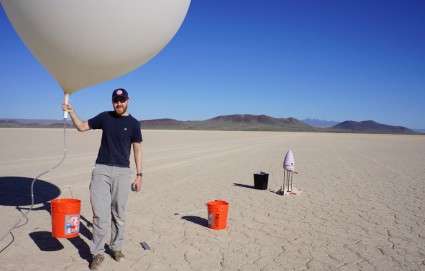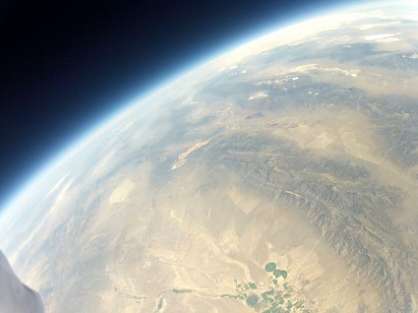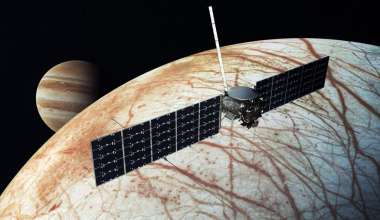When searching for inspiration for his latest, interplanetary engineering concept, Aerospace’s Matt Eby decided to keep things close to home — relatively speaking. Eby’s sister, Mars geologist Rebecca Williams — who recently published a widely circulated report detailing the discovery of an ancient Martian streambed — had repeatedly expressed her frustration at the lack of diversity in Martian exploratory vehicles. Aside from the decidedly complex rovers that seemed to emerge every decade or so, Williams balked at the limited numbers of observational outlets available to Mars specialists.
With his sister’s perspective in mind, Eby quickly realized that relatively cheap, CubeSat technology could provide a solution to the current bottleneck in Mars-serving probes. Thus, the concept for a low-cost Mars lander was born.

“She’s always gotten me interested in Mars,” Eby says of his sister, who is a senior research scientist at the Tucson-based Planetary Science Institute. “She used to do some of the on-orbit camera-targeting for Mars — taking high-resolution pictures. This was about a decade ago and I was visiting her and it was my birthday. As a gift, she let me select where on Mars I wanted to take a picture. So, I picked this one crater and drew a narrow swath across it, and a few days later, it came back: a great high-resolution image. And I spent hours looking at that one image because it was the only high-resolution image of that one spot on Mars. And it was so spectacular. And it’s amazing how much on Mars we’ve never explored because we’ve only been to a handful of spots.”
It is with that intrepid sense of discovery and wonder that Eby and Mechanical Systems Department support staff members Ash Peltz and Vivian Churchill — supported by the Aerospace Independent Research and Development (IRAD) program — set about designing an economical vehicle for Martian exploration as part of the MarsDrop project.
MarsDrop’s basic goal is to repurpose Aerospace’s Reentry Breakup Recorder (REBR) vehicle as a planetary micro-probe for use in a Mars-based mission. The current aeroshell that houses a given REBR vehicle is aerodynamically stable and well-suited for Mars entry. Eby and his team have developed a landing system for the REBR vehicle that leaves volume within the spacecraft for scientific experimentation.
The MarsDrop, which would hitch a ride to the red planet as a secondary payload aboard a Mars mission, will also make use of a style of gliding parachute known as a parawing that was developed in the 1960s for the Apollo and Gemini missions. The parawing’s lift creates less vertical speed than a standard parachute, which enhances steering capacity and enables long-distance gliding. The gliding capability of the MarsDrop is one of its most exciting features, allowing for potentially stunning flyovers of the Martian surface.
The large, wildly expensive Mars rovers (Curiosity, Opportunity) are incredibly complex and remarkable in their ability to collect data and execute numerous functions while exploring the planet, but they are hamstrung by budget limitations and the sheer, physical size of the vehicles. The MarsDrop, though technologically rudimentary by comparison, offers a low-cost means of exploring Mars that can be utilized in a host of different mission plans. Eby sees potential for solo scientific missions, flyover missions, and even fleet missions that spread a group of landers over a spectrum of the Martian landscape.
In May of this year, Eby and Churchill performed an initial test of the technology in the Nevada desert by sending a MarsDrop lander up to 80,00 feet in a weather balloon and then cutting it free — forcing an earthly descent. Unlike the expensive rovers, MarsDrop landers can be tested under representative conditions on Earth without fear of financial catastrophe due to a potential crash or malfunction. “You could test this in a wind tunnel,” says Eby, “but the problem with a wind tunnel is that you are at sea level. It doesn’t match what the atmosphere on Mars is like. It’s not cold. It’s not a near-vacuum. But in high altitudes on Earth the atmosphere is very thin, very cold, and almost a near-vacuum, which is about what the Mars surface atmosphere is like.”
In its initial test, the MarsDrop lander performed well, though an electrical short prevented its parawing from deploying, forcing the lander to use one of its backup parachutes. “This first flight was a lot about just seeing whether we could get the experiment to work. It was a great learning experience,” says Eby.

Over the next year, Eby and his team plan to test the lander a few more times in order to prove the concept. Once all of the kinks are ironed out, the group will have developed a compact, cost-effective vessel for future scientific exploration on Mars. “You can’t replace a three billion dollar Mars rover with a million dollar, six-pound lander,” says Eby. “The rovers can do amazing things. But the lander will be a good complement. You can send them out very inexpensively, scout out high-risk areas and do some simple science.”
One of the more fanciful applications that the Aerospace team has dreamed up is a flyover of Mars’ magnificent canyon system A Valles Marineris. Aside from its scientific utility, Eby sees the lander — and its potential for theatrical flyovers — as a wonderful PR tool for current and future Mars missions. “To say this is the first time we’ve ever flown over Mars or flown on Mars, I think it would capture the interest of the public,” says Eby. “On the last mission that landed on Mars, they had a descent imager that captured a minute or two of video. It’s really quite spectacular. Imagine doing something similar to that over ten minutes of imagery. That would be quite interesting.”
With a mere six pounds of entry mass, the MarsDrop would be the first micro-probe to ever land on Mars and the first vehicle to ever fly within the confines of the red planet. That seems quite interesting, indeed.









